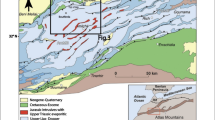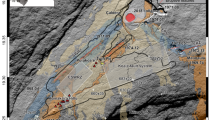Abstract
Only a few high precision studies of lava and tephra during simultaneous explosive and effusive activity have so far been undertaken. We carried out such measurements by analysis of a unique and homogeneous multi-temporal dataset of high-spatial resolution satellite optical images. Digital Elevation Models (DEMs) and orthophotos (with 1- and 0.5-m-pixel resolutions respectively) were extracted from six specifically tasked Pleiades tri-stereo pairs of Mt. Etna volcano, between 2011 and 2016. During this period, frequent effusive and explosive events formed lava flow fields and built up the new south-east crater pyroclastic cone. The volumes of lava fields and proximal pyroclastic deposits were measured by comparing the Pleiades DEMs with an aerial photogrammetric DEM updated in 2007. The volumes of all distal deposits were estimated using lava and tephra partitioning from the literature for an Etnean lava fountain. The dense rock equivalent volume of lava and tephra, calculated to be 248.4 ± 2.1 × 106 m3 in total, corresponds to an average output rate of 0.98 m3/s over the analysed 8-year period (May 2008–May 2016) and to a multi-event eruption rate of 5.53 m3/s for 520 days of activity. The multi-temporal analysis of high-spatial resolution satellite DEMs, here successfully applied to the well-monitored Etna volcano, demonstrated that the tasking of high-spatial resolution satellite images is crucial for fast and effective monitoring during intense volcanic activity (frequent and overlapping eruptive events). This methodology could be used for the monitoring of remote or hazardous volcanoes that are difficult to study by means of repeated field surveys.







Similar content being viewed by others
References
Andronico D, Behncke B, De Beni E, Cristaldi A, Scollo S, Lopez M, Lo Castro MD (2018) Magma budget from lava and tephra volumes erupted during the 25-26 October 2013 lava fountain at Mt Etna. Front Earth Sci 6:116. https://doi.org/10.3389/feart.2018.00116
Baldi P, Fabris M, Marsella M, Monticelli R (2005) Monitoring the morphological evolution of the Sciara del Fuoco during the 2002–2003 Stromboli eruption using multi-temporal photogrammetry. ISPRS J Photogramm Remote Sens 59:199–211
Bagnardi M, González PJ, Hooper A (2016) High-resolution digital elevation model from tri-stereo Pleiades satellite imagery for lava flow volume estimates at Fogo Volcano. Geophys Res Lett 43:6267–6275. https://doi.org/10.1002/2016GL069457
Behncke B, Branca S, Corsaro RA, De Beni E, Miraglia L, Proietti C (2014) The 2011–2012 summit activity of Mount Etna: birth, growth and products of the new SE crater. J Volcanol Geotherm Res 270:10–21. https://doi.org/10.1016/j.jvolgeores.2013.11.012
Behncke B, Fornaciai A, Neri M, Favalli M, Ganci G, Mazzarini F (2016) Lidar surveys reveal eruptive volumes and rates at Etna, 2007–2010. Geophys Res Lett 43:4270–4278. https://doi.org/10.1002/2016GL068495
Boissin MB, Gleyzes A, Tinel C (2012) The Pleiades system and data distribution. In: IEEE International Geoscience and Remote Sensing Symposium, Munich, Germany, pp 7098–7101
Bonaccorso A, Calvari S (2013) Major effusive eruptions and recent lava fountains: balance between expected and erupted magma volumes at Etna volcano. Geophys Res Lett 40:6069–6073. https://doi.org/10.1002/2013GL058291
Bonny E, Thordarson T, Wright R, Höskuldsson A, Jónsdóttir I (2018) The volume of lava erupted during the 2014 to 2015 eruption at Holuhraun, Iceland: a comparison between satellite- and ground-based measurements. J Geophys Res Solid Earth 123:5412–5426. https://doi.org/10.1029/2017JB015008
Calvari S, Coltelli M, Neri M, Pompilio M, Scrivano V (1994) The 1991-1993 Etna eruption: chronology and lava flow-field evolution. Acta Volcanol 4:1–14
Coltelli M, Proietti C, Branca S, Marsella M, Andronico D, Lodato L (2007) Analysis of the 2001 lava flow eruption of Mt. Etna from three-dimensional mapping. J Geophys Res 112:F02029. https://doi.org/10.1029/2006JF000598
Coltelli M, D’Aranno PJV, De Bonis R, Guerrero F, Marsella M, Nardinocchi C, Pecora E, Proietti C, Scifoni S, Scutti M, Wahbeh W (2017) The use of surveillance cameras for the rapid mapping of lava flow: an application to Mount Etna Volcano. Remote Sens 9:192. https://doi.org/10.3390/rs9030192
Corsaro RA, Andronico D, Behncke B, Branca S, De Beni E, Caltabiano T, Ciancitto F, Cristaldi A, De Beni E, La Spina A, Lodato L, Miraglia L, Neri M, Salerno G, Scollo S, Spata G (2017) Monitoring the December 2015 summit eruptions of Mt. Etna (Italy): implications on eruptive dynamics. J Volcanol Geotherm Res 341:53–69. https://doi.org/10.1016/j.jvolgeores.2017.04.018
De Beni E, Behncke B, Branca S, Nicolosi I, Carluccio R, D’Ajello Caracciolo F, Chiappini M (2015) The continuing story of Etna’s New Southeast Crater (2012–2014): evolution and volume calculations based on field surveys and aerophotogrammetry. J Volcanol Geotherm Res 303:175–186. https://doi.org/10.1016/j.jvolgeores.2015.07.021
Dvigalo V, Shevchenko A, Svirid I (2016) Photogrammetric survey in volcanology: a case study for Kamchatka active volcanoes. In: Nemeth K (ed) Updates in volcanology - from volcano modelling to volcano geology. InTech, pp 55–79. https://doi.org/10.5772/63577
Eisank C, Rieg L, Klug C, Kleindienst H (2015) Semi-global matching of Pleiades tri-stereo imagery to generate detailed digital topography for high-alpine regions. GI_Forum – J Geogr Inf Sc 3:168–177. https://doi.org/10.1553/giscience2015s168
Francis P, Rothery D (2000) Remote sensing of active volcanoes. Annu Rev Earth Planet Sci 28:81–106
Fraser CS, Dial G, Grodecki J (2006) Sensor orientation via RPCs. ISPRS J Photogramm Remote Sens 60(3):182–194
Ganci G, Vicari A, Cappello A, Del Negro C (2012) An emergent strategy for volcano hazard assessment: from thermal satellite monitoring to lava flow modelling. Remote Sens Environ 119:197–207
Ganci G, Cappello A, Bilotta G, Herault A, Zago V, Del Negro C (2018) Mapping volcanic deposits of the 2011–2015 Etna eruptive events using satellite remote sensing. Front Earth Sci 6:83. https://doi.org/10.3389/feart.2018.00083
Gwinner K, Coltelli M, Flohrer J, Jaumann R, Matz KD, Marsella M, Roatsch T, Scholten F, Trauthan F (2006) The HRSC-AX Mt. Etna project: high-resolution orthoimages and 1 m DEM at regional scale. In: Proceedings ISPRS Archives 23, 1, From Sensors to Imagery (Paris, 4–6 July 2006), 6 pp, T05–23
Harris AJL, Dehn J, Calvari S (2007) Lava effusion rate definition and measurement: a review. Bull Volcanol 70:1–22. https://doi.org/10.1007/s00445-007-0120-y
Harris AJL, Steffke A, Calvari S, Spampinato L (2011) Thirty years of satellite-derived lava discharge rates at Etna: implications for steady volumetric output. J Geophys Res 116:B08204. https://doi.org/10.1029/2011JB008237
Honda K, Nagai M (2002) Real-time volcano activity mapping using ground-based digital imagery. ISPRS J Photogramm Remote Sens 57:159–168
http://volcano.iterre.fr/svo_projects. Accessed 18 March 2019
Kubanek J, Westerhaus M, Heck B (2017) TanDEM-X time series analysis reveals lava flow volume and effusion rates of the 2012–2013 Tolbachik, Kamchatka fissure eruption. J Geophys Res Solid Earth 122:7754–7774. https://doi.org/10.1002/2017JB014309
Marsella M, Proietti C, Sonnessa A, Coltelli M, Tommasi P, Bernardo E (2009) The evolution of the Sciara del Fuoco subaerial slope during the 2007 Stromboli eruption: relation between deformation processes and effusive activity. J Volcanol Geotherm Res 182:201–213
Marsella M, Nardinocchi C, Proietti C, Daga L, Coltelli M (2014) Monitoring active volcanos using aerial images and the orthoview tool. Remote Sens 6:12166–12186. https://doi.org/10.3390/rs61212166
Martino M, Marsella M, Scifoni S Coltelli M, Proietti C, Chowdhury TA, Minet C, Giannone F (2016) Monitoring an active volcanic area and mapping lava flows with multisource data: the case of Mount Etna from 2011 to 2015. EEEIC 2016 - International Conference on Environment and Electrical Engineering, 7–10 June 2016. https://doi.org/10.1109/EEEIC.2016.7555732
Mouginis-Mark PJ, Pieri DC, Francis PW, Wilson L, Self S, Rose WI, Wood CA (1989) Remote sensing of volcanos and volcanic terrains. EOS Trans Am Geophys Union 70:1567–1575. https://doi.org/10.1029/89EO00396
Naranjo MF, Ebmeier SK, Vallejo S, Ramón P, Mothes P, Biggs J, Herrera F (2016) Mapping and measuring lava volumes from 2002 to 2009 at El Reventador Volcano, Ecuador, from field measurements and satellite remote sensing. J Appl Volcanol 5:8. https://doi.org/10.1186/s13617-0160048-z
Neri M, De Maio M, Crepaldi S, Suozzi E, Lavy M, Marchionatti F, Calvari S, Buongiorno MF (2017) Topographic maps of Mount Etna’s summit craters, updated to December 2015. J Maps 13(2):674–683. https://doi.org/10.1080/17445647.2017.1352041
Rowland S, Harris A, Wooster M, Amelung F, Garbeil H, Wilson L, Mouginis-Mark P (2003) Volumetric characteristics of lava flows from interferometric radar and multispectral satellite data: the 1995 Fernandina and 1998 Cerro Azul eruptions in the western Galapagos. Bull Volcanol 65:311–330. https://doi.org/10.1007/s00445-002-0262-x
Stevens NF, Wadge G, Murray JB (1999) Lava flow volume and morphology from digitised contour maps: a case study at Mount Etna, Sicily. Geomorphology 28:251–261
Wadge G (1981) The variation of magma discharge during basaltic eruptions. J Volcanol Geotherm Res 11:139–168
www.pcigeomatics.com. Accessed 18 March 2019
Acknowledgements
We acknowledge Pierre Briole and Marcello de Michele for providing Pleiades data, analysed in this work, through the Space Volcano Observatory sur Pleiades (SVOP) project (http://volcano.iterre.fr/svo_projects). We are grateful to Massimo Fabris for processing the Worldview 2012 data to extract the DEM of the NSEC cone. We are grateful to Eisuke Fujita, an anonymous reviewer and the associate editor, Michael R. James, for their comments and feedback which greatly improved this manuscript and to William Moreland for improving the English.
Author information
Authors and Affiliations
Corresponding author
Additional information
Editorial responsibility: M.R. James
Rights and permissions
About this article
Cite this article
Proietti, C., Coltelli, M., Marsella, M. et al. Towards a satellite-based approach to measure eruptive volumes at Mt. Etna using Pleiades datasets. Bull Volcanol 82, 35 (2020). https://doi.org/10.1007/s00445-020-01374-8
Received:
Accepted:
Published:
DOI: https://doi.org/10.1007/s00445-020-01374-8




